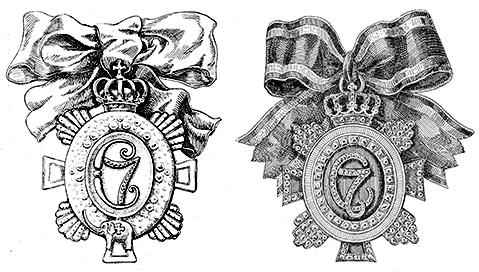After Queen Caroline Mathilde was exiled in 1772, there was a need for a new house order to replace the
Order of Queen Caroline Mathilde.
As a result King Christian VII instituted a new order on October 21st, 1774. This order is later known as the "Order of King Christian VII" or the "Order Tessera Concordiæ".
The order was solely bestowed on members of the royal family. It could be awarded to both men and women and was worn from a ribbon on the chest - for women the ribbon was tied in a bow.
The badge of the order
No surviving badges of the order are known to exist, so the description is based mainly on paintings and - very different - descriptions from the period.
 The presumed appearance of the badge
The presumed appearance of the badge
(after Grandjean "De Kongelige Danske Ridderordener")
The badge is a crowned round medallion set with diamonds. In the center is the King's monogram on a red background and around the monogram the King's motto "Gloria ex amore patriae".
The medallion rested on a cross and below the medallion was an enamelled elephant.
The reverse of the badge is engraved "Tessera Concordiæ" ("Sign of Agreement")
Different descriptions of the badge are known.
It was probably the intention to relate the order to both the Order of the Elephant and the
Order of Dannebrog. The ribbon was also a combination of the ribbons of those two orders - blue
with red and white edge stripes.
The use of the order faded out after the Dowager Queen Juliane Marie died in 1796.
There are no known statutes for the order.
Sources:
Grandjean, H.F "De Kongelige Danske Ridderordener" (1903)
Stevnsborg, Lars "Kongeriget Danmarks Ordener, Medaljer og Hæderstegn" (2005)